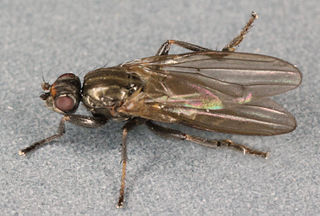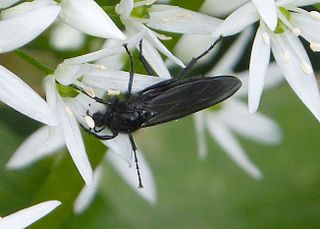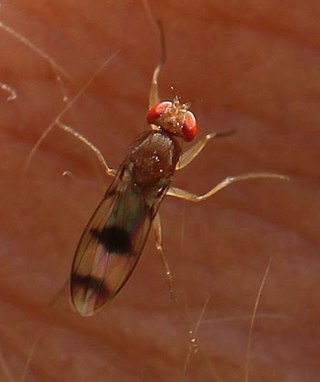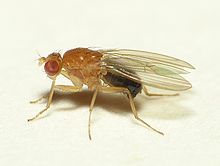
The Drosophilidae are a diverse, cosmopolitan family of flies, which includes species called fruit flies, although they are more accurately referred to as vinegar or pomace flies. Another distantly related family of flies, Tephritidae, are true fruit flies because they are frugivorous, and include apple maggot flies and many pests. The best known species of the Drosophilidae is Drosophila melanogaster, within the genus Drosophila, also called the "fruit fly." Drosophila melanogaster is used extensively for studies concerning genetics, development, physiology, ecology and behaviour. Many fundamental biological mechanisms were discovered first in D. melanogaster. The fruit fly is mostly composed of post-mitotic cells, has a very short lifespan, and shows gradual aging. As in other species, temperature influences the life history of the animal. Several genes have been identified that can be manipulated to extend the lifespan of these insects. Additionally, Drosophila subobscura, also within the genus Drosophila, has been reputed as a model organism for evolutionary-biological studies, along with D. sechellia for the evolution of host specialization on the toxic noni fruit and Scaptomyza flava for the evolution of herbivory and specialist on toxic mustard leaves.

The Drosophilinae are the largest subfamily in the Drosophilidae. The other subfamily is the Steganinae.

Tipula hortorum is a species of cranefly which is widespread throughout the West Palaearctic.It is a woodland species.

Calliopum aeneum is a species of fly in the family Lauxaniidae. It is found in the Palearctic. The larva is a stem miner of Trifolium pratense.

Tricholauxania praeusta is a species of fly in the family Lauxaniidae. It is found in the Palearctic . The larvae are saprophagous.

Copromyza nigrina is a species of fly in the family Sphaeroceridae. It is found in the Palearctic.

Chymomyza fuscimana is a species of fly in the family Drosophilidae. It is found in the Palearctic.

Stegana coleoptrata is a species of fly in the family Drosophilidae. It is found in the Palearctic.

Minettia inusta is a species of fly in the family Lauxaniidae. It is found in the Palearctic.

Sapromyza quadripunctata is a species of fly in the family Lauxaniidae. It is found in the Palearctic.

Nephrotoma flavescens is a species of fly in the family Tipulidae. It is found in the Palearctic.

Dilophus febrilis is a species of feverfly the family Bibionidae. It is found in the Palearctic.

Diastata costata is a species of fly in the family Diastatidae. It is found in the Palearctic.

Renocera stroblii is a species of fly in the family Sciomyzidae. It is found in the Palearctic

Trichopalpus fraternus is a species of fly in the family Scathophagidae. It is found in the Palearctic.

Chymomyza is a genus of vinegar flies.

Scaptomyza is a genus of vinegar flies, insects in the family Drosophilidae. As of 2022, there are 273 described species of Scaptomyza. Of those, 148 are endemic to the Hawaiian archipelago. This genus is part of the species-rich lineage of Hawaiian Drosophilidae, and is the sister lineage to the endemic Hawaiian Drosophila. The genus Scaptomyza is one of several nested within the paraphyletic genus Drosophila.

Lordiphosa is a genus of fly in the family Drosophilidae.

Palloptera umbellatarum is a species of fly in the family Pallopteridae. It is found in the Palearctic.

Palloptera saltuum is a species of fly in the family Pallopteridae. It is found in the Palearctic.



















